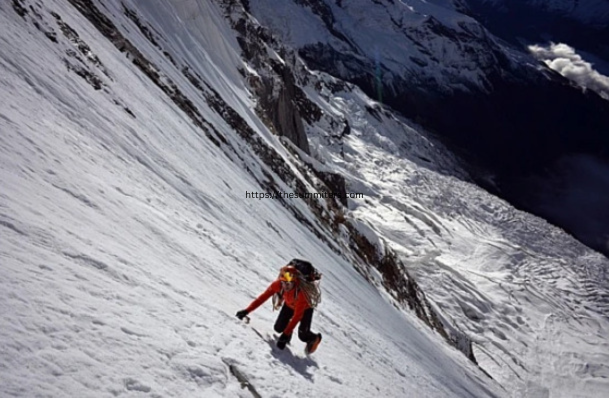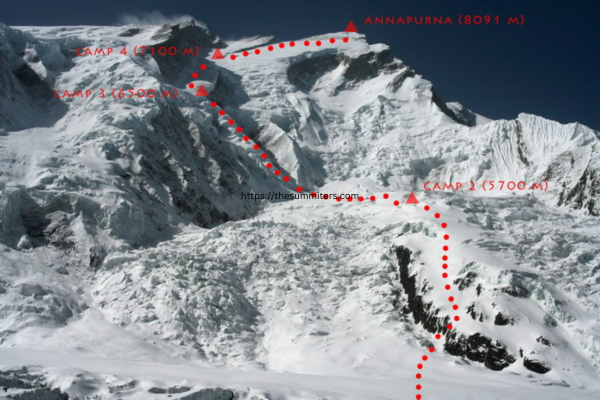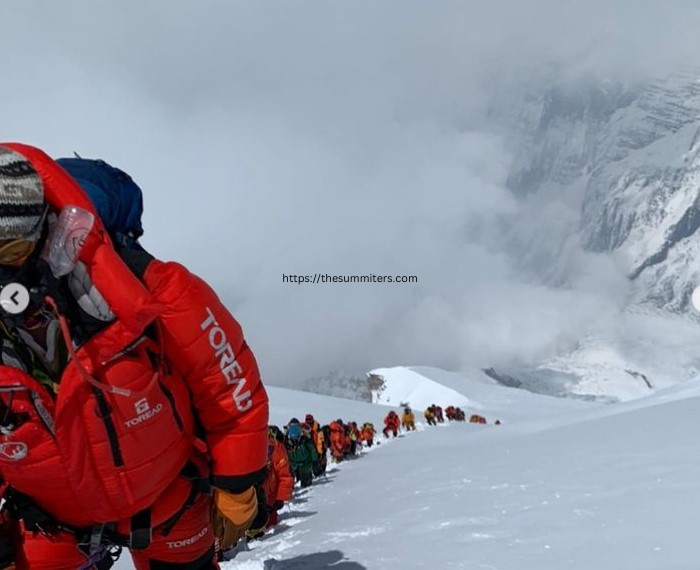Teams started their journey towards Annapurna Base Camp last week with some hopeful climbers aiming for the summit by the week’s end.
Reflecting on the past two decades it’s remarkable to see how Annapurna has evolved. In the old days, it was a mountain with fewer adventurers, a dauntingly low success rate, and numerous tragic incidents. Yet, it also offered a heightened sense of adventure, with additional faces to challenge climbers. However, today, the landscape has changed. While the mountain still presents risks, they’re not as severe as they once were.
2024 – Time is of the Essence
Seven Summit Treks, the dedicated team tasked with securing ropes along Annapurna‘s treacherous routes, finds themselves racing against the clock. Every moment counts, as the sooner they complete their work, the quicker they can pivot their efforts towards other towering challenges like Dhaulagiri and Everest.
In just a handful of days, the resilient Sherpa rope fixers have made impressive progress, reaching as far as Camp 2 on Annapurna’s unforgiving slopes.
“Our goal is to finish securing the remaining section from Camp 2 to the summit by April 2,” shared expedition leader Chhang Dawa Sherpa, his determination palpable.
Despite the looming threat of inclement weather, as observed by Allie Pepper from Australia, who bravely forgoes supplementary oxygen, the rope team persists tirelessly in their mission.
Annapurna stands as a evidence to mountaineering history having been conquered for the first time in 1950 by Maurice Herzog and Louis Lachenal of France. However as the years passed its reputation shifted, becoming one of the least attempted and summited peaks among the revered 8,000-meter peaks around the globe.
1970s-2010s: The Era of the Brave
During these decades Annapurna continued to draw expeditions almost yearly despite its daunting challenges. Summit opportunities were rare and climbers faced significant risks with the primary goal being a safe descent. Only the most seasoned and self sufficient climbers dared to tackle its slopes.

The 70s and 80s left memorable marks on Annapurna‘s mountaineering legacy. Notably the UK team’s groundbreaking ascent of the South Face in 1970, led by Chris Bonington and achieved by Doug Haston and Don Whillans, stands out. This era also witnessed the contentious Guinness World Record climb of the Northwest Face in 1985 by Messner and Kammerlander. Additionally, Jerzy Kukuczka and Artur Hajzer’s triumphant winter ascent in 1987 added to the mountain’s lore.
Despite these feats, Annapurna remained a magnet for climbers seeking the ultimate challenge. Some pushed boundaries by exploring new, highly demanding routes on the imposing South Face or the seemingly endless East Ridge. Others aimed to replicate Messner‘s daring achievement on the Northwest Face in 1986.
Venturing onto the avalanche-prone north side was a gamble taken by few, navigating either the classic French or German routes. Due to its inherent danger, Annapurna often stood as the final frontier for climbers endeavoring to conquer all 14 of the world’s 8,000-meter peaks. Tragically, the mountain claimed the lives of exceptional climbers like Alex MacIntyre, Inaki Ochoa de Olza, Young-Seok Park, and Anatoli Boukreev, underscoring its unforgiving nature.
2015 – A Shift in Climbing Trends
The 2010s marked a notable evolution in climbing practices. Prior to this era, it was rare to see climbers relying on supplementary oxygen during their ascents. However, around 2010, there was a gradual emergence of climbers from countries like India and China, as well as a few Sherpas, who opted for oxygen-assisted climbs.

Then, in 2015, a significant turning point occurred. The number of climbers using oxygen not only equaled but surpassed those undertaking climbs without it. Moreover, there was a remarkable surge in the participation of Nepalese climbers, signifying a shift in the demographics of mountaineering.
What’s intriguing is the emergence of Seven Summit Treks in The Himalayan Database’s records for Annapurna during this period. Interestingly, the company’s founders, Chhang Dawa Sherpa and Mingma Sherpa, had already conquered Annapurna themselves in 2010 and 2011, despite this being the first time their company’s name appeared in the records. However, the third founder, Tashi Lakpa Sherpa, had yet to undertake the climb.
Between 2015 and 2023, only five expeditions dared to explore routes other than the usual North Face, but none achieved success. Throughout this decade, Adam Bielecki persisted in pursuing a different goal: creating a new route on the NW Face. His fourth attempt in 2023, alongside Pawel Haldas, took an unexpected turn when they ended up rescuing Anurag Maloo of India on the normal route. Interestingly, this spring, Bielecki has chosen not to venture to Nepal, marking a departure from his previous climbing pursuits.
The ‘Most Dangerous’ Title Returns to Pakistan’s Nanga Parbat
According to data from The Himalayan Database Annapurna boasts 476 successful summits alongside 73 tragic fatalities. Typically the risk assessment for 8,000 meter peaks involves a simple calculation dividing the number of successful summits by the number of fatalities.

This analysis now reveals that Annapurna no longer holds the problematical distinction of being the most perilous 8,000 meter peak. Instead that title reverts to its original owner the infamous ‘Killer Mountain’ Nanga Parbat, as per meticulous statistics compiled by Rodrigo Granzotto from Brazil. (It’s essential to note that The Himalayan Database does not encompass records from Pakistan.)
But does this shift mean Annapurna has suddenly become a safer climb? Not exactly. The standard route still harbors considerable risks, particularly the looming threat of avalanches, especially in the treacherous stretch between Camp 2 and Camp 3. This section of the mountain is notorious for its precarious ice barriers, from which sizable chunks of serac frequently break off, posing a significant danger to climbers.
Why Climbers Are Safer Now
One significant change today is the remarkable increase in the number of climbers reaching the summit during the climbing seasons. Throughout the entirety of the 20th century, starting from its historic first ascent in 1950, only 110 individuals managed to conquer Annapurna. Surprisingly, in just the past two years, there have been 111 summits alone (recorded between 2022-2023). This recent surge in successful climbs has certainly shifted the statistical landscape, but there’s more to this story.

Expedition logistics have undergone substantial improvements, featuring the implementation of fixed ropes, widespread utilization of supplemental oxygen, and the presence of larger teams comprising rope fixers and supportive sherpas. These enhancements have directly contributed to heightened safety measures, as climbers now spend less time navigating the treacherous terrain. Utilizing equipment like jumars along fixed ropes has significantly accelerated climbers’ ascents, and the availability of supplemental oxygen enables them to reach the summit in just one rotation, or even none at all in some cases.
Nepalese guides bring invaluable expertise, possessing an intimate knowledge of every twist and turn along the route. This familiarity enables them to pinpoint the safest spots for setting up lines and establishing camps, enhancing overall safety for climbers. Cutting-edge technology, such as drones, provides crucial assessments of conditions in sections beyond climbers’ reach, while helicopters have revolutionized rescue operations. In a groundbreaking move in 2021, helicopters were even deployed to deliver supplies to teams positioned as high as Camp 4.
This trend of improved safety measures isn’t limited to Annapurna alone. Presently, efforts to install fixed ropes on Dhaulagiri, led by the Pioneer Adventure team, are progressing at a similar rapid pace, with Camp 2 already prepared for incoming climbers. The sophisticated logistical strategies honed on Everest have been seamlessly adapted and implemented across all 14 of the highest peaks.
However, it’s crucial to recognize that despite these advancements, the formidable challenges posed by these mountains, particularly Annapurna, persist. Each climbing season witnesses daring rescues, some of which verge on miraculous. Tragically, fatalities still occur, as evidenced by Noel Hannah’s tragic passing due to illness during his descent from the mountain last year. It’s a stark reminder that achieving zero risk is an unattainable aspiration on any mountain, especially ones of such towering magnitude.